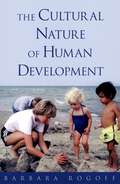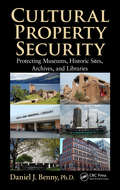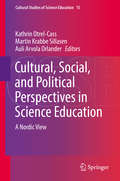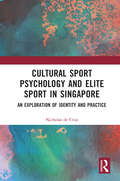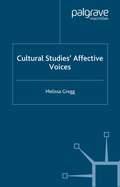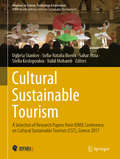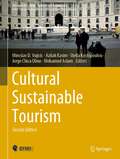- Table View
- List View
The Cultural Lives of Whales and Dolphins
by Hal Whitehead Luke RendellIn the songs and bubble feeding of humpback whales; in young killer whales learning to knock a seal from an ice floe in the same way their mother does; and in the use of sea sponges by the dolphins of Shark Bay, Australia, to protect their beaks while foraging for fish, we find clear examples of the transmission of information among cetaceans. Just as human cultures pass on languages and turns of phrase, tastes in food (and in how it is acquired), and modes of dress, could whales and dolphins have developed a culture of their very own? Unequivocally: yes. In The Cultural Lives of Whales and Dolphins, cetacean biologists Hal Whitehead, who has spent much of his life on the ocean trying to understand whales, and Luke Rendell, whose research focuses on the evolution of social learning, open an astounding porthole onto the fascinating culture beneath the waves. As Whitehead and Rendell show, cetacean culture and its transmission are shaped by a blend of adaptations, innate sociality, and the unique environment in which whales and dolphins live: a watery world in which a hundred-and-fifty-ton blue whale can move with utter grace, and where the vertical expanse is as vital, and almost as vast, as the horizontal. Drawing on their own research as well as a scientific literature as immense as the sea—including evolutionary biology, animal behavior, ecology, anthropology, psychology, and neuroscience—Whitehead and Rendell dive into realms both humbling and enlightening as they seek to define what cetacean culture is, why it exists, and what it means for the future of whales and dolphins. And, ultimately, what it means for our future, as well.
The Cultural Lives of Whales and Dolphins
by Hal Whitehead Luke RendellIn the songs and bubble feeding of humpback whales; in young killer whales learning to knock a seal from an ice floe in the same way their mother does; and in the use of sea sponges by the dolphins of Shark Bay, Australia, to protect their beaks while foraging for fish, we find clear examples of the transmission of information among cetaceans. Just as human cultures pass on languages and turns of phrase, tastes in food (and in how it is acquired), and modes of dress, could whales and dolphins have developed a culture of their very own? Unequivocally: yes. In The Cultural Lives of Whales and Dolphins, cetacean biologists Hal Whitehead, who has spent much of his life on the ocean trying to understand whales, and Luke Rendell, whose research focuses on the evolution of social learning, open an astounding porthole onto the fascinating culture beneath the waves. As Whitehead and Rendell show, cetacean culture and its transmission are shaped by a blend of adaptations, innate sociality, and the unique environment in which whales and dolphins live: a watery world in which a hundred-and-fifty-ton blue whale can move with utter grace, and where the vertical expanse is as vital, and almost as vast, as the horizontal. Drawing on their own research as well as a scientific literature as immense as the sea—including evolutionary biology, animal behavior, ecology, anthropology, psychology, and neuroscience—Whitehead and Rendell dive into realms both humbling and enlightening as they seek to define what cetacean culture is, why it exists, and what it means for the future of whales and dolphins. And, ultimately, what it means for our future, as well.
The Cultural Lives of Whales and Dolphins
by Hal Whitehead Luke RendellIn the songs and bubble feeding of humpback whales; in young killer whales learning to knock a seal from an ice floe in the same way their mother does; and in the use of sea sponges by the dolphins of Shark Bay, Australia, to protect their beaks while foraging for fish, we find clear examples of the transmission of information among cetaceans. Just as human cultures pass on languages and turns of phrase, tastes in food (and in how it is acquired), and modes of dress, could whales and dolphins have developed a culture of their very own? Unequivocally: yes. In The Cultural Lives of Whales and Dolphins, cetacean biologists Hal Whitehead, who has spent much of his life on the ocean trying to understand whales, and Luke Rendell, whose research focuses on the evolution of social learning, open an astounding porthole onto the fascinating culture beneath the waves. As Whitehead and Rendell show, cetacean culture and its transmission are shaped by a blend of adaptations, innate sociality, and the unique environment in which whales and dolphins live: a watery world in which a hundred-and-fifty-ton blue whale can move with utter grace, and where the vertical expanse is as vital, and almost as vast, as the horizontal. Drawing on their own research as well as a scientific literature as immense as the sea—including evolutionary biology, animal behavior, ecology, anthropology, psychology, and neuroscience—Whitehead and Rendell dive into realms both humbling and enlightening as they seek to define what cetacean culture is, why it exists, and what it means for the future of whales and dolphins. And, ultimately, what it means for our future, as well.
The Cultural Lives of Whales and Dolphins
by Hal Whitehead Luke RendellIn the songs and bubble feeding of humpback whales; in young killer whales learning to knock a seal from an ice floe in the same way their mother does; and in the use of sea sponges by the dolphins of Shark Bay, Australia, to protect their beaks while foraging for fish, we find clear examples of the transmission of information among cetaceans. Just as human cultures pass on languages and turns of phrase, tastes in food (and in how it is acquired), and modes of dress, could whales and dolphins have developed a culture of their very own? Unequivocally: yes. In The Cultural Lives of Whales and Dolphins, cetacean biologists Hal Whitehead, who has spent much of his life on the ocean trying to understand whales, and Luke Rendell, whose research focuses on the evolution of social learning, open an astounding porthole onto the fascinating culture beneath the waves. As Whitehead and Rendell show, cetacean culture and its transmission are shaped by a blend of adaptations, innate sociality, and the unique environment in which whales and dolphins live: a watery world in which a hundred-and-fifty-ton blue whale can move with utter grace, and where the vertical expanse is as vital, and almost as vast, as the horizontal. Drawing on their own research as well as a scientific literature as immense as the sea—including evolutionary biology, animal behavior, ecology, anthropology, psychology, and neuroscience—Whitehead and Rendell dive into realms both humbling and enlightening as they seek to define what cetacean culture is, why it exists, and what it means for the future of whales and dolphins. And, ultimately, what it means for our future, as well.
The Cultural Lives of Whales and Dolphins
by Hal Whitehead Luke RendellIn the songs and bubble feeding of humpback whales; in young killer whales learning to knock a seal from an ice floe in the same way their mother does; and in the use of sea sponges by the dolphins of Shark Bay, Australia, to protect their beaks while foraging for fish, we find clear examples of the transmission of information among cetaceans. Just as human cultures pass on languages and turns of phrase, tastes in food (and in how it is acquired), and modes of dress, could whales and dolphins have developed a culture of their very own? Unequivocally: yes. In The Cultural Lives of Whales and Dolphins, cetacean biologists Hal Whitehead, who has spent much of his life on the ocean trying to understand whales, and Luke Rendell, whose research focuses on the evolution of social learning, open an astounding porthole onto the fascinating culture beneath the waves. As Whitehead and Rendell show, cetacean culture and its transmission are shaped by a blend of adaptations, innate sociality, and the unique environment in which whales and dolphins live: a watery world in which a hundred-and-fifty-ton blue whale can move with utter grace, and where the vertical expanse is as vital, and almost as vast, as the horizontal. Drawing on their own research as well as a scientific literature as immense as the sea—including evolutionary biology, animal behavior, ecology, anthropology, psychology, and neuroscience—Whitehead and Rendell dive into realms both humbling and enlightening as they seek to define what cetacean culture is, why it exists, and what it means for the future of whales and dolphins. And, ultimately, what it means for our future, as well.
The Cultural Lives of Whales and Dolphins
by Hal Whitehead Luke RendellIn the songs and bubble feeding of humpback whales; in young killer whales learning to knock a seal from an ice floe in the same way their mother does; and in the use of sea sponges by the dolphins of Shark Bay, Australia, to protect their beaks while foraging for fish, we find clear examples of the transmission of information among cetaceans. Just as human cultures pass on languages and turns of phrase, tastes in food (and in how it is acquired), and modes of dress, could whales and dolphins have developed a culture of their very own? Unequivocally: yes. In The Cultural Lives of Whales and Dolphins, cetacean biologists Hal Whitehead, who has spent much of his life on the ocean trying to understand whales, and Luke Rendell, whose research focuses on the evolution of social learning, open an astounding porthole onto the fascinating culture beneath the waves. As Whitehead and Rendell show, cetacean culture and its transmission are shaped by a blend of adaptations, innate sociality, and the unique environment in which whales and dolphins live: a watery world in which a hundred-and-fifty-ton blue whale can move with utter grace, and where the vertical expanse is as vital, and almost as vast, as the horizontal. Drawing on their own research as well as a scientific literature as immense as the sea—including evolutionary biology, animal behavior, ecology, anthropology, psychology, and neuroscience—Whitehead and Rendell dive into realms both humbling and enlightening as they seek to define what cetacean culture is, why it exists, and what it means for the future of whales and dolphins. And, ultimately, what it means for our future, as well.
The Cultural Nature of Human Development
by Barbara RogoffThree-year-old Kwara'ae children in Oceania act as caregivers of their younger siblings, but in the UK, it is an offense to leave a child under age 14 ears without adult supervision. In the Efe community in Zaire, infants routinely use machetes with safety and some skill, although U.S. middle-class adults often do not trust young children with knives. What explains these marked differences in the capabilities of these children? Until recently, traditional understandings of human development held that a child's development is universal and that children have characteristics and skills that develop independently of cultural processes. Barbara Rogoff argues, however, that human development must be understood as a cultural process, not simply a biological or psychological one. Individuals develop as members of a community, and their development can only be fully understood by examining the practices and circumstances of their communities.
The Cultural Nature of Human Development
by Barbara RogoffThree-year-old Kwara'ae children in Oceania act as caregivers of their younger siblings, but in the UK, it is an offense to leave a child under age 14 ears without adult supervision. In the Efe community in Zaire, infants routinely use machetes with safety and some skill, although U.S. middle-class adults often do not trust young children with knives. What explains these marked differences in the capabilities of these children? Until recently, traditional understandings of human development held that a child's development is universal and that children have characteristics and skills that develop independently of cultural processes. Barbara Rogoff argues, however, that human development must be understood as a cultural process, not simply a biological or psychological one. Individuals develop as members of a community, and their development can only be fully understood by examining the practices and circumstances of their communities.
Cultural Phylogenetics: Concepts and Applications in Archaeology (Interdisciplinary Evolution Research #4)
by Larissa Mendoza StraffonThis book explores the potential and challenges of implementing evolutionary phylogenetic methods in archaeological research, by discussing key concepts and presenting concrete applications of these approaches.The volume is divided into two parts: The first covers the theoretical and conceptual implications of using evolution-based models in the sociocultural domain, illustrates the sorts of questions that these methods can help answer, and invites the reader to reflect on the opportunities and limitations of these perspectives. The second part comprises case studies that address relevant empirical issues, such as inferring patterns and rates of cultural transmission, detecting selective pressures in cultural evolution, and explaining the nature of cultural variation. This book will appeal to archaeologists interested in applying evolutionary thinking and inferential methods to their field, and to anyone interested in cultural evolution studies.
Cultural Politics and the Transatlantic Divide over GMOs: Cultures Of Nature
by H. StephanAlongside other factors, cultural values and identities help to explain different regulatory frameworks for genetically modified organisms. This book uses insights from environmental history and sociology to illuminate the cultural politics of regulation in the US and the EU, with particular attention to public opinion and anti-GMO activism.
Cultural Politics in Latin America
by NA NAThe relations of culture and politics in Latin America have been transformed in recent decades. Cultural Politics in Latin America offers unprecedented insights into this process, with contributions from leading intellectuals and academics working in and outside the region. Chapters range across fields as diverse as music and anthropology, sociology and cultural memory, politics and (post)modern theorizing, economics, communications and cultural globalization, poetry, narrative and drama, and all are contextualized in the extended Introduction in Latin America.
The Cultural Politics of Blood, 1500-1900
by Ralph Bauer Carla L. Peterson Kimberly Anne Coles Zita NunesThe essays of this collection explore how ideas about 'blood' in science and literature have supported, at various points in history and in various places in the circum-Atlantic world, fantasies of human embodiment and human difference that serve to naturalize existing hierarchies.
Cultural Practices and Infectious Crop Diseases (Advanced Series in Agricultural Sciences #9)
by Josef PaltiThe development of a crop, and therefore its health, is always the result of interplay between biological and environmental factors, as influenced by human agency. In other words, crop health is a highly complex affair. This book is concerned with only one group of agents affecting crop health, the pathogens, and not with animal pests or direct effects of physiological or weather factors. Even within this one group, however, the interaction of causal agents with environmental and biotic factors is highly complex. No less complex is the effect of cultural practices on the crop and its health. There is probably no major practice that does not affect diverse facets of crop growth, which in turn affects crop/pathogen relationships. Thus tillage se quentially affects depth and rate of root development, hence nutrient uptake, hence general plant size and habit as well as crop climate and crop susceptibility. Irri gation affects all these parameters, and facilitates crop growth under diverse macro climatic conditions, with all the ensuing implications for disease development. In this book an attempt is made to superimpose one set of complexities, the cul tural practices, on another such set, crop health. This may seem overambitious, not to say foolhardy, unless we remember that it has been done by farmers, consciously or unconsciously, ever since the beginnings of agriculture. We are here chiefly try ing to rationalize traditional practices, review modern research on the development of further practices, and assess the place of the latter in integrated disease control.
Cultural Property Security: Protecting Museums, Historic Sites, Archives, and Libraries
by Daniel J. BennyThe protection and security of cultural properties is of primary concern to the thousands of federal, state, county, city, and private institutions entrusted with housing and displaying our national heritage and history of our society. Cultural property security is of global importance as well, with tens of thousands of institutions internationally
Cultural Selection
by A. Fog1. INTRODUCTION This book describes a new interdisciplinary theory for explaining cultural change. In contrast to traditional evolutionist theories, the present theory stresses the fact that a culture can evolve in different directions depending on its life conditions. Cultural selection theory explains why certain cultures or cultural ele ments spread, possibly at the expense of other cultures or cultural elements which then disappear. Cultural elements include social structure, traditions, religion, rituals, art, norms, morals, ideologies, ideas, inventions, knowledge, technology, etc. This theory is inspired by Charles Darwin's idea of natural selection, because cultural elements are seen as analogous to genes in the sense that they may be reproduced from generation to generation and they may undergo change. A culture may evolve because certain cultural elements are more likely to spread and be reproduced than others, analogously to a species evolving because individuals possessing certain traits are more fit than others to reproduce and transmit these traits to their offspring.
Cultural Selection (Elements in the Philosophy of Biology)
by null Tim LewensHumans learn in ways that are influenced by others. As a result, cultural items of many types are elaborated over time in ways that build on the achievements of previous generations. Culture therefore shows a pattern of descent with modification reminiscent of Darwinian evolution. This raises the question of whether cultural selection-a mechanism akin to natural selection, albeit working when learned items are passed from demonstrators to observers-can explain how various practices are refined over time. This Element argues that cultural selection is not necessary for the explanation of cultural adaptation; it shows how to build hybrid explanations that draw on aspects of cultural selection and cultural attraction theory; it shows how cultural reproduction makes problems for highly formalised approaches to cultural selection; and it uses a case-study to demonstrate the importance of human agency for cumulative cultural adaptation.
Cultural Severance and the Environment: The Ending of Traditional and Customary Practice on Commons and Landscapes Managed in Common (Environmental History #2)
by Ian D. RotherhamThis major book explores commons, lands and rights of usage in common, traditional and customary practices, and the cultural nature of ‘landscapes’. Importantly, it addresses now critical matters of ‘cultural severance’ and largely unrecognized impacts on biodiversity and human societies, and implications for conservation, sustainability, and local economies. The book takes major case studies and perspectives from around the world, to address contemporary issues and challenges from historical and ecological perspectives. The book developed from major international conferences and collaborations over around fifteen years, culminating ‘The End of Tradition?’ in Sheffield, UK, 2010. The chapters are from individuals who are both academic researchers and practitioners. These ideas are now influencing bodies like the EU, UNESCO, and FAO, with recognition by major organisations and stakeholders, of the critical state of the environment consequent on cultural severance.
Cultural, Social, and Political Perspectives in Science Education: A Nordic View (Cultural Studies of Science Education #15)
by Kathrin Otrel-Cass Martin Krabbe Sillasen Auli Arvola OrlanderThis book presents a collection of critical thinking that concern cultural, social and political issues for science education in the Nordic countries. The chapter authors describe specific scenarios to challenge persisting views, interrogate frameworks and trouble contemporary approaches to researching teaching and learning in science. Taking a point of departure in empirical examples from the Nordic countries the collection of work is taking a critical sideways glance at the Nordic education principles. Critical examinations target specifically those who are researching in the fields of science education research to question whether conventional research approaches, foci and theoretical approaches are sufficient in a world of science education that is neither politically neutral, nor free of cultural values. Attention is not only on the individual learner but on the cultural, social and political conditions and contexts in science education. The different chapters review debates and research in teacher education, school teaching and learning including when external stakeholders are involved. Even though the chapters are contextualized in Nordic settings there will be similarities and parallels that will be informative to the international science education research community.
Cultural Sport Psychology and Elite Sport in Singapore: An Exploration of Identity and Practice
by Nicholas de CruzGuided by the principles of cultural sport psychology (CSP), this book explores the psychosocial issues surrounding elite sport and psychological practice in Singapore. CSP recognises the importance of understanding people as individuals, rather than objectifying and interpreting psychological processes independent of the socio-cultural context in which they stem from. For sport psychology to progress, it is imperative to distinguish and appreciate the difference between treating someone the same (i.e., culturally blind approach) and treating them equally (i.e., possess cultural awareness). To address the paucity of cultural-specific research, this book explores the psychosocial issues of elite sport in Singapore using CSP as a theoretical and guiding philosophy. Given Singapore’s recent successes at the Olympic and Paralympic levels, this book is ideally timed to investigate the social and cultural developments of elite sport as they occur in a specific sociocultural context. The authors argue that if elite sport and sport psychology is to progress in Singapore, there is a need to refine its elite ecosystem, regulate the practice of sport psychology, and work towards establishing a professional community centred around a culture of constructive exchange, debate and cooperation. This book presents a blueprint to any researcher, national institute, or practitioner, to systematically explore the culture and context within which they operate and organise action plans to address unique needs that were identified through this process.
Cultural Sport Psychology and Elite Sport in Singapore: An Exploration of Identity and Practice
by Nicholas de CruzGuided by the principles of cultural sport psychology (CSP), this book explores the psychosocial issues surrounding elite sport and psychological practice in Singapore. CSP recognises the importance of understanding people as individuals, rather than objectifying and interpreting psychological processes independent of the socio-cultural context in which they stem from. For sport psychology to progress, it is imperative to distinguish and appreciate the difference between treating someone the same (i.e., culturally blind approach) and treating them equally (i.e., possess cultural awareness). To address the paucity of cultural-specific research, this book explores the psychosocial issues of elite sport in Singapore using CSP as a theoretical and guiding philosophy. Given Singapore’s recent successes at the Olympic and Paralympic levels, this book is ideally timed to investigate the social and cultural developments of elite sport as they occur in a specific sociocultural context. The authors argue that if elite sport and sport psychology is to progress in Singapore, there is a need to refine its elite ecosystem, regulate the practice of sport psychology, and work towards establishing a professional community centred around a culture of constructive exchange, debate and cooperation. This book presents a blueprint to any researcher, national institute, or practitioner, to systematically explore the culture and context within which they operate and organise action plans to address unique needs that were identified through this process.
Cultural Studies' Affective Voices
by M. GreggIn a series of encounters with key figures in the field of cultural studies, this book draws together interest in affect theory and contemporary politics to describe the mobilising effects of individual scholarly voices in cultural studies' history, emphasising the ongoing importance of engaged, public intellectualism throughout.
Cultural Studies and Environmentalism: The Confluence of EcoJustice, Place-based (Science) Education, and Indigenous Knowledge Systems (Cultural Studies of Science Education #3)
by Deborah J. Tippins Michael P. Mueller Michiel Eijck Jennifer D. AdamsAs the first book to explore the confluence of three emerging yet critical fields of study, this work sets an exacting standard. The editors’ aim was to produce the most authoritative guide for ecojustice, place-based education, and indigenous knowledge in education. Aimed at a wide audience that includes, but is not restricted to, science educators and policymakers, Cultural Studies and Environmentalism starts from the premise that schooling is a small part of the larger educational domain in which we live and learn. Informed by this overarching notion, the book opens up ways in which home-grown talents, narratives, and knowledge can be developed, and eco-region awareness and global relationships can be facilitated. Incorporating a diversity of perspectives that include photography, poetry and visual art, the work provides a nuanced lens for evaluating educational problems and community conditions while protecting and conserving the most threatened and vulnerable narratives. Editors and contributors share the view that the impending loss of these narratives should be discussed much more widely than is currently the case, and that both teachers and children can take on some of the responsibility for their preservation. The relevance of ecojustice to this process is clear. Ecojustice philosophy is a way of learning about how we frame, or perceive, the world around us—and why that matters. Although it is not synonymous with social or environmental justice, the priorities of ecojustice span the globe in the same way. It incorporates a deep recognition of the appropriateness and significance of learning from place-based experiences and indigenous knowledge systems rather than depending on some urgent “ecological crises” to advocate for school and societal change. With a multiplicity of diverse voices coming together to explore its key themes, this book is an important starting point for educators in many arenas. It brings into better focus a vital role for the Earth’s ecosystems in the context of ecosociocultural theory and participatory democracy alike. “Encompassing theoretical, empirical, and experiential standpoints concerning place-based knowledge systems, this unique book argues for a transformation of (science) education’s intellectual tradition of thinking that emphasizes individual cognition. In its place, the book offers a wisdom tradition of thinking, living, and being that emphasizes community survival in harmony within itself and with Mother Earth.” Glen Aikenhead
The Cultural Study of Yiddish in Early Modern Europe
by J. FrakesA unique analysis of the intensive interest in Jewish culture of early modern Christian Humanists as a part of their comprehensive program of study of Greek, Latin, and Hebrew. The book focuses on how that interest was particularly manifested in a score of treatises on Sixteenth and Seventeenth Century Yiddish language and literature.
Cultural Sustainable Tourism: A Selection of Research Papers from IEREK Conference on Cultural Sustainable Tourism (CST), Greece 2017 (Advances in Science, Technology & Innovation)
by Uglješa Stankov Sofia-Natalia Boemi Sahar Attia Stella Kostopoulou Nabil MoharebThis book includes research papers submitted to and presented during the first international conference on Cultural Sustainable Tourism (CST) that was held in Thessaloniki, Greece in November of 2017. Discussing complex relations between Culture, tourism, and the role of planners and architects in their maintenance, this conference was jointly organized by IEREK –International Experts for Research Enrichment and Knowledge Exchange- and Aristotle University of Thessaloniki. The conference was an attempt to shed a light on the significance of Culture and Heritage as two important factors attracting tourists and promoting economic growth and convey civilizations through tourism. Themes covered in this book give an overview on current research and topics of discussion that focus on Cultural sustainable tourism through several sections. The first section, titled “Art, Architecture and Culture”, discusses urban regeneration as a road to the preservation of cultural and tourist destinations and the importance of understanding and benefitting from our heritage to allow for modern day improvements. “Heritage Tourism”, the section 2 of the book, is more focused on offering nontraditional solutions and management plans to sustain cultural tourism and improve quality of life around historically significant areas. The third section on the “City and Rural Tourism” follows by providing sustainable strategies to attract tourists and promoting the use of existing resources. The last and final section with the title of “Sustainable Tourism, Development and Environmental Management” maneuvers around the different yet common environmental issues existing today and proposes new and innovative solutions for their elimination. Presenting a wide range of topics in chapters, this book provides the scientific community with a collection of unique and enlightening literature.
Cultural Sustainable Tourism (Advances in Science, Technology & Innovation)
by Miroslav D. Vujicic Azilah Kasim Stella Kostopoulou Jorge Chica Olmo Mohamed AslamThis book is an assemblage of diverse yet homogenous research papers that bring together the issues and challenges of cultural heritage conservation and tourism sustainability. The richness of this book stems from its inclusion of diverse case studies from around the globe while scrutinizing the cases of both deterioration and sustainability of cultural heritage belonging to different eras.This book sheds light on the connections between culture as an essential dimension of local sustainability and cultural dimensions of sustainable tourism, further contributing to the complex discussion between culture and tourism. This book gives an overview of current research and subjects of discussion that focuses on cultural sustainable tourism through several sections, such as planning and management of sustainable tourism, sustainable cultural tourism development in a digital era, social and economic impacts of cultural tourism, and sustainable tourism development in urban areas

